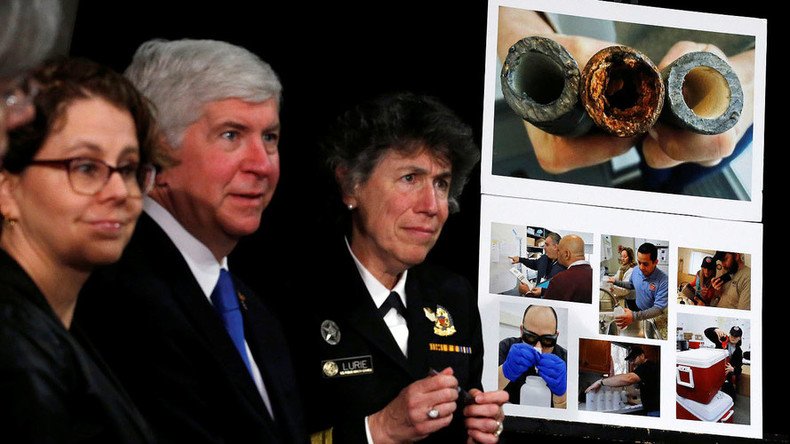Flint water bills set to double, residents will pick up check

The water crisis in Flint, Michigan isn’t going away anytime soon, and it could prove costly for city residents. Water bills are set to double in the coming years and chlorine residual levels remain a problem.
The hits keep on coming for Flint residents, and the cost of fixing the ongoing water crisis in the city will likely be far higher than previous projections, including the $60 million estimate from Michigan Governor Rick Snyder or the $55 million program called for by Flint Mayor Karen Weaver.
Skyrocketing water bills
Replacing and updating Flint’s water infrastructure will cost more than $214 million, Flint-based engineering firm Rowe Professional Services said in a 63-page report obtained by the Detroit Free Press. The city will need to replace 13 miles of water mains ever year for the next 50 years, repair or replace five dams, and switch out at least 2,000 lead service lines annually for the next five years, the company wrote.
The cost of replacing the roughly 10,000 lead pipes carrying water to homes and businesses will be $80 million and could take as long as eight years, according to the report, as cited by the Free Press.
"The water main infrastructure has been severely damaged," Virginia Tech Professor Marc Edwards, the researcher who initially discovered the lead in Flint’s water, said during an appearance last week. "We have to get these water mains upgraded so they they are not being fixed on failure."
Unfortunately, though, no one knows exactly how many lead pipes there are in the city.
"One of things that was very clear early on is that city records are incomplete and possibly inaccurate," retired National Guard Brigadier General Michael C.H. McDaniel, who has been advising the city and its mayor on the crisis, told the Free Press.
NAACP sues Michigan officials over Flint water crisishttps://t.co/WT9FcT2V44pic.twitter.com/a0vPJ1QBRw
— RT America (@RT_America) May 19, 2016
Flint’s water bills are already some of the highest in the US, and the city’s residents have been forced to pay them throughout the crisis. A May report by the Michigan Department of Treasury found that their bills could double over the next five years if the system is not upgraded and certain costs remain fixed ‒ even if Flint switches its water source to a cheaper one. It doesn’t help that the water system has a declining customer base, according to the Rowe report, and that thousands of gallons of water that were paid for have gone missing.
Chlorine residuals not adequate
The US Environmental Protection Agency has been concerned about chlorine residual levels, an important post-treatment safeguard against the risk of microbial contamination, in the city’s water since January, when the EPA’s Safe Drinking Water Task Force met with the utilities administrator.
“With the onset of warmer weather, the situation is urgent," the EPA wrote in a Friday letter to Weaver and Michigan Department of Environmental Quality Director Keith Creagh, as cited by the Flint Journal.
“It is encouraging that EPA sampling this week has shown adequate chlorine residuals at each of the 24 sites we tested,” the letter said. “However, as chlorine decay increases with warmer water temperatures, EPA is concerned that the Respondents will not be capable of maintaining chlorine residuals that follow best practices and are protective of public health.”
The letter focused on the addition of chlorine at two reservoirs ‒ Cedar Street and West Side ‒ and making sure the chemical doesn’t reach the entire distribution system because Flint “does not currently have the equipment or means of adding additional chlorine or caustic at the Flint Water Treatment Plant (WTP) to consistently protect public health throughout the distribution system."
The EPA’s letter comes just days after Edwards’ researchers announced that Flint’s water is okay for bathing and handwashing. The team of scientists reviewed samples from homes and buildings in the city, and found that the city's water meets all federal standards for levels of chloroform, disinfection byproducts such as chlorine, and total trihalomethanes (TTHMs).
Dictators in charge
While many politicians have played the blame game over the water crisis, a controversial figure in the county has entered the fray with strong language against the state-appointed emergency manager who was in charge of the financially strapped city in April 2014, when Flint switched its source of tap water from Detroit’s system to the nearby Flint River in a cost-cutting move. Operators at Flint’s water treatment plant then failed to treat the water to make it less corrosive, causing older lead pipes to dissolve into the tap water. State health authorities ultimately confirmed that elevated blood-lead levels had been found in children.
“They put dictators into Flint ‒ they called them emergency managers,” Robert J. Pickell, a Genesee County sheriff whose district includes Flint, said in a documentary about the Flint water crisis.
“One of the emergency managers signed off on the Flint River without all of the safeguards built in,” Pickell added. “Now they’re all pointing their fingers at each other, but the lesson has got to be that you cannot take government from the people.”
In March, Pickell survived a recall attempt after he only repaid the county $15,000 of the more than $129,000 he was mistakenly given. The Genesee County Board of Elections rejected the petition due to its language, the Flint Journal reported at the time.
Music festival brings hope
There is some positive news for the city, however. Over the weekend, the Vehicle City Fest took over downtown Flint, and the proceeds from the three-day music festival benefited the Flint Child Health and Development Fund, the Flint Journal reported. More than 50 bands performed at the event.
The fund aids children up to six years in age with health and development, early childhood education, healthy food access, and nutrition education. It has raised more than $6 million since it was established. Donations made between May 11 and December 31 will be matched (up to $5 million) by the Charles Stewart Mott Foundation.














